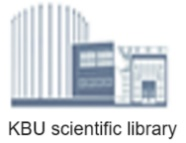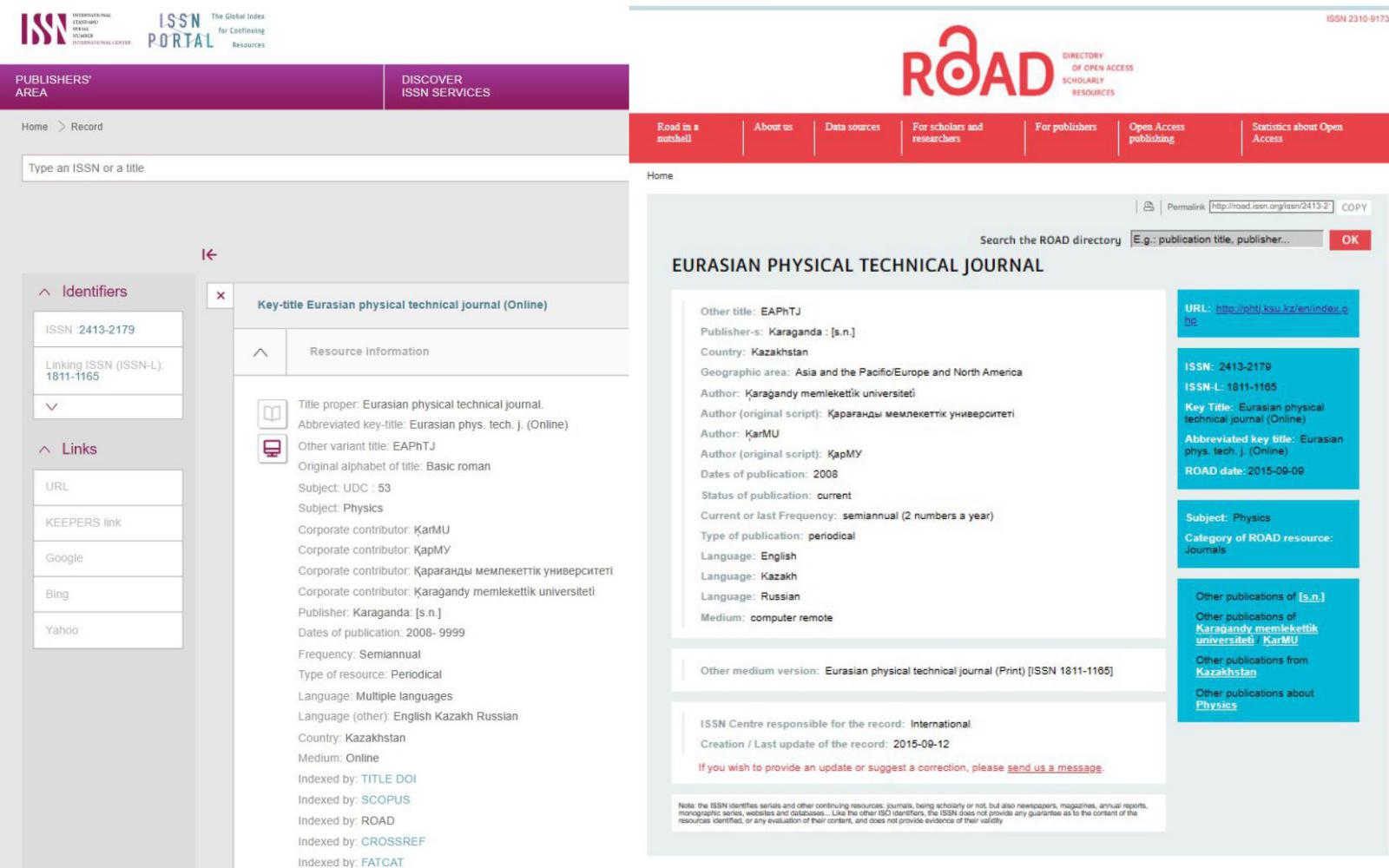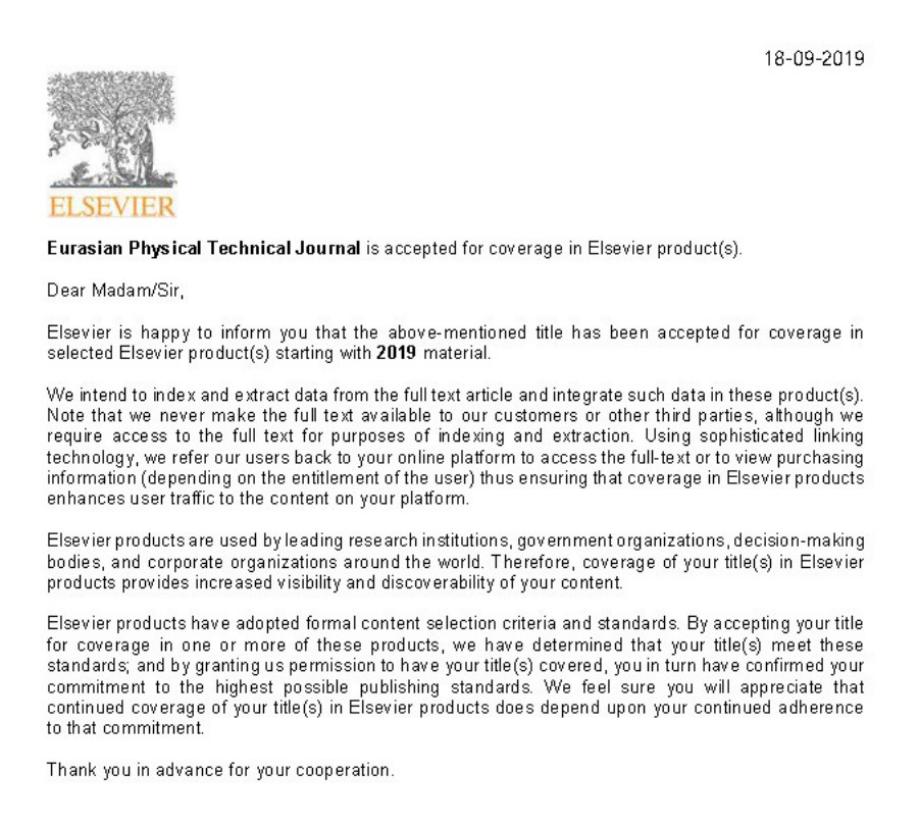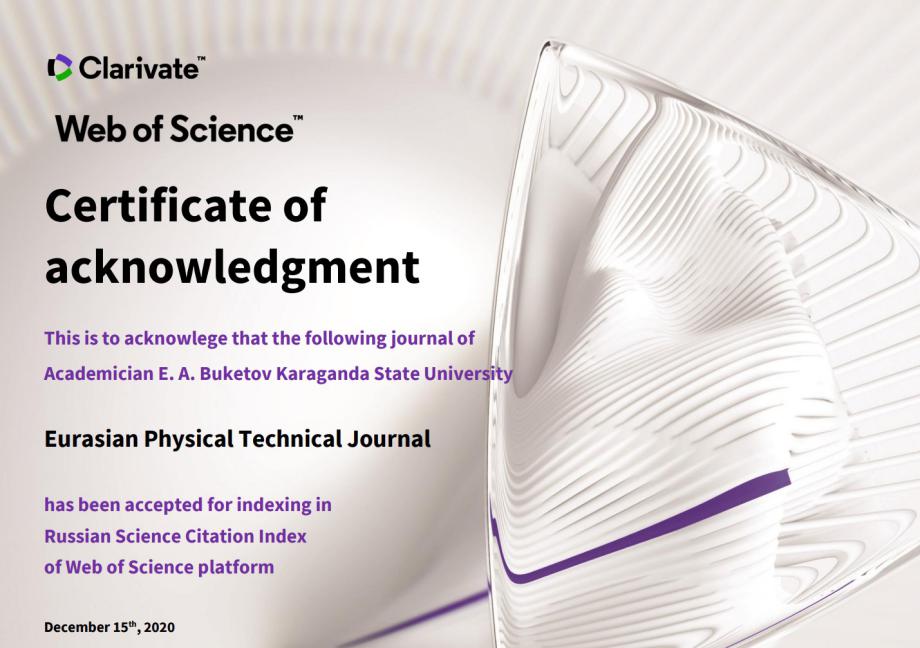Эффект внутреннего тяжелого атома на генерации синглетного кислорода в присутствии плазмонных наночастиц
DOI:
https://doi.org/10.31489/2025N2/5-12Ключевые слова:
эффект тяжёлого атома, интеркомбинационная конверсия, синглетный кислород, наноплазмоника, фотосенсибилизаторАннотация
Исследован эффект тяжёлого атома на генерацию синглетного кислорода в плазмонном поле наночастиц серебра. В качестве сенсибилизаторов использованы красители родамин 123 и дибромродамин 123 в плёнках поливинилбутираля. Плёнки красителей были нанесены методом спин-коутинга на островковые плёнки серебра, синтезированные на поверхности кварцевых подложек. Полученные результаты показали, что присутствие атома брома в молекуле красителя увеличивает эффективность производства синглетного кислорода. Вычисленные константы Штерна-Фольмера демонстрируют усиление тушения молекулярным кислородом триплетных состояний молекул красителя дибромродамин 123 в присутствии наночастиц Ag.
Библиографические ссылки
Sagadevan A., Hwang K.C., Su M.D. (2017) Singlet oxygen-mediated selective C–H bond hydroperoxidation of ethereal hydrocarbons. Nature Communications, 8(1), 1812. https://doi.org/10.1038/s41467-017-01906-5 DOI: https://doi.org/10.1038/s41467-017-01906-5
Schmidt R. (2006). Photosensitized generation of singlet oxygen. Photochemistry and Photobiology, 82(5), 1161–1177. https://doi.org/10.1562/2006-03-03-IR-833 DOI: https://doi.org/10.1562/2006-03-03-lR-833
Ishchenko A.A., Syniugina A.T. (2023) Structure and photosensitiser ability of polymethine dyes in photodynamic therapy: A review. Theoretical and Experimental Chemistry, 58(6), 373–401. https://doi.org/10.1007/s11237-023-09754-9 DOI: https://doi.org/10.1007/s11237-023-09754-9
Singleton D. A., Hang C., Szymanski M. J., Meyer M. P., Leach A. G., Kuwata K. T., Chen J. S., Greer A., Foote C.S., Houk K.N. (2003) Mechanism of the reactions of singlet oxygen: A two-step no-intermediate mechanism. Journal of the American Chemical Society, 125(5), 1319–1328. https://doi.org/10.1021/ja027225p DOI: https://doi.org/10.1021/ja027225p
Aerssens D., Cadoni E., Tack L., Madder A. (2022) A photosensitized singlet oxygen (1O2) toolbox for bio-organic applications: Tailoring 1O2 generation for DNA and protein labelling, targeting and biosensing. Molecules, 27(3), 778. https://doi.org/10.3390/molecules27030778 DOI: https://doi.org/10.3390/molecules27030778
Bregnhøj M., Prete M., Turkovic V., Petersen A. U., Nielsen M.B., Madsen M., Ogilby P.R. (2019) Oxygen-dependent photophysics and photochemistry of prototypical compounds for organic photovoltaics: Inhibiting degradation initiated by singlet oxygen at a molecular level. Methods and Applications in Fluorescence, 8(1), 014001. https://doi.org/10.1088/2050-6120/ab4edc DOI: https://doi.org/10.1088/2050-6120/ab4edc
Pibiri I., Buscemi S., Palumbo Piccionello A., Pace A. (2018) Photochemically produced singlet oxygen: Applications and perspectives. ChemPhotoChem, 2(7), 535–547. https://doi.org/10.1002/cptc.201800076 DOI: https://doi.org/10.1002/cptc.201800076
Wang Y., Lin Y., He S., Wu S., Yang C. (2024). Singlet oxygen: Properties, generation, detection, and environmental applications. Journal of Hazardous Materials, 461, 132538. https://doi.org/10.1016/j.jhazmat. 2023.132538 DOI: https://doi.org/10.1016/j.jhazmat.2023.132538
Khan A., Alam M., Rehman S. U., Khan G. S., Khan F.A., Khan M., Zhang Y. (2019) Rhodamine-based fluorescent probes for bioimaging applications. Chemical Reviews, 119(19), 10504–10555. https://doi.org/10.1021/acs.chemrev.9b00230 DOI: https://doi.org/10.1021/acs.chemrev.9b00230
Rao D., Singh P., Jain R. (2020) Applications of singlet oxygen in photodynamic therapy enhanced by plasmonic nanostructures. Journal of Biomedical Nanotechnology, 16(5), 843–856. https://doi.org/10.1166/jbn.2020.2914 DOI: https://doi.org/10.1166/jbn.2020.2914
Ogawa K., Kobuke Y. (2016) Heavy atom effects in photochemical and photobiological applications. Accounts of Chemical Research, 49(5), 712–721. https://doi.org/10.1021/acs.accounts.6b00027 DOI: https://doi.org/10.1021/acs.accounts.6b00027
Lakowicz J.R. (2006) Principles of fluorescence spectroscopy (3rd ed.). Springer. https://doi.org/10.1007/978-0-387-46312-4 DOI: https://doi.org/10.1007/978-0-387-46312-4
Chowdhury M.H., Ray K. (2008) Plasmon-controlled fluorescence towards high-sensitivity optical sensing. Advances in Biochemical Engineering/Biotechnology, 116, 29–72. https://doi.org/10.1007/10_2008_9
Ray K., Chowdhury M.H., Zhang J., Fu Y., Szmacinski H., Nowaczyk K., Lakowicz J.R. (2009) Plasmon-controlled fluorescence towards high-sensitivity optical sensing. Advances in Biochemical Engineering/Biotechnology, 116, 29–72. https://doi.org/10.1007/10_2008_9 DOI: https://doi.org/10.1007/10_2008_9
Zhang Y., Xu C., Hao Y. (2015) Influence of heavy atoms on intersystem crossing and singlet oxygen generation in photodynamic systems. Journal of Photochemistry and Photobiology A: Chemistry, 306, 44–52. https://doi.org/10.1016/j.jphotochem.2015.04.006 DOI: https://doi.org/10.1016/j.jphotochem.2015.04.006
Ibrayev N.K., Valiev R.R., Seliverstova E.V., Menshova E.P., Nasibullin R.T., Sundholm D. (2024) Molecular phosphorescence enhancement by the plasmon field of metal nanoparticles. Physical Chemistry Chemical Physics, 26(20), 14624–14636. https://doi.org/10.1039/d4cp01281j DOI: https://doi.org/10.1039/D4CP01281J
Ibrayev N., Seliverstova E., Valiev R., Aymagambetova A., Sundholm D. (2024). The effect of heavy atoms on the deactivation of electronic excited states of dye molecules near the surface of metal nanoparticles. Physical Chemistry Chemical Physics, 26(40), 25986–25993. https://doi.org/10.1039/D4CP02621G DOI: https://doi.org/10.1039/D4CP02621G
DeRosa M.C., Crutchley R.J. (2002). Photosensitized singlet oxygen and its applications. Coordination Chemistry Reviews, 233–234, 351–371. https://doi.org/10.1016/S0010-8545(02)00034-6 DOI: https://doi.org/10.1016/S0010-8545(02)00034-6
Kamalova D.I., Abdrazakova L.R., Salakhov M.Kh. (2020) Poly(vinyl butyral)/poly(ethylene glycol) blends for gas separation membranes: Coefficients of diffusion and permeability of oxygen. Journal of Non-Crystalline Solids, 532, 120304. https://doi.org/10.1016/j.jnoncrysol.2020.120304 DOI: https://doi.org/10.1016/j.jnoncrysol.2020.120304
Ibrayev N., Seliverstova E., Temirbayeva D., Ishchenko A. (2022) Plasmon effect on simultaneous singlet-singlet and triplet-singlet energy transfer. Journal of Luminescence, 251, 119203. https://doi.org/10.1016/ j.jlumin.2022.119203 DOI: https://doi.org/10.1016/j.jlumin.2022.119203
Minaev B.F. (2007) Electronic mechanisms of molecular oxygen activation. Russian Chemical Reviews, 76(11), 988–1010. https://doi.org/10.1070/RC2007v076n11ABEH003720 DOI: https://doi.org/10.1070/RC2007v076n11ABEH003720
Seliverstova E., Ibrayev N., Omarova G., Ishchenko A., Kucherenko M. (2021) Competitive influence of the plasmon effect and energy transfer between chromophores and Ag nanoparticles on the fluorescent properties of indopolycarbocyanine dyes. Journal of Luminescence, 235, 118000. https://doi.org/10.1016/j.jlumin.2021.118000 DOI: https://doi.org/10.1016/j.jlumin.2021.118000
Kanapina A., Seliverstova E., Ibrayev N., Derevyanko N., Ishchenko A. (2023) Features of the decay of excited states of ionic dyes in the near field of metal nanoparticles. Eurasian Physical Technical Journal, 20, 2(44), 106–111. https://doi.org/10.31489/2023No2/106-111 DOI: https://doi.org/10.31489/2023NO2/106-111
Temirbayeva D., Ibrayev N., Kucherenko M. (2022). Distance dependence of plasmon-enhanced fluorescence and delayed luminescence of molecular planar nanostructures. Journal of Luminescence, 243, 118642. https://doi.org/10.1016/j.jlumin.2021.118642 DOI: https://doi.org/10.1016/j.jlumin.2021.118642
Gehlen M. H. (2020) The centenary of the Stern–Volmer equation of fluorescence quenching: From the single line plot to the SV quenching map. Journal of Photochemistry and Photobiology C: Photochemistry Reviews, 42, 100338. https://doi.org/10.1016/j.jphotochemrev.2019.100338 DOI: https://doi.org/10.1016/j.jphotochemrev.2019.100338
Krasnovsky A.A. (2008) Luminescence and photochemical studies of singlet oxygen photonics. Journal of Photochemistry and Photobiology A: Chemistry, 196(2–3), 210–218. https://doi.org/10.1016/j.jphotochem.2007.12.015 DOI: https://doi.org/10.1016/j.jphotochem.2007.12.015














